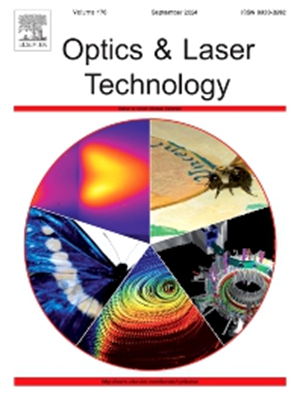Mechanisms of crack formation and suppression strategies in laser pulsed welding of 3J01 high elastic alloy and 1J22 soft magnetic alloy
IF 4.6
2区 物理与天体物理
Q1 OPTICS
引用次数: 0
Abstract
The joining of 3J01 and 1J22 alloys is widely used in precision electronic equipment and aviation system integration to meet structural demands for magnetic isolation and mechanical support. However, the welding process for these dissimilar materials often exhibits instability, frequently leading to defects such as cracks. Building upon this foundation, this study systematically investigates the thermal–mechanical behavior and crack formation mechanisms during laser pulsed welding of dissimilar 3J01 and 1J22 alloys through an integrated simulation-experimental approach. The results indicate that crack initiation is directly linked to stress concentration at the leading edge of the melt pool on the 3J01 base metal, and the excessive Ti content around the crack area increases the brittleness temperature range during the solidification process of melt pool. To mitigate this issue, a laser preheating technique was introduced, when the preheating parameters were set to a laser power of 1.2 kW, frequency of 30 Hz, pulse width of 4 ms, and welding speed of 8 mm/s, the peak stress was reduced by 13 % compared to the weld without preheating, with a significant reduction in high-stress regions. In conclusion, the preheating method significantly reduces the number of hot cracks in the welds of dissimilar 3J01 and 1J22 alloys during pulsed laser welding, effectively suppresses the propagation of transverse cracks, and greatly enhances the overall quality of the weld.
求助全文
约1分钟内获得全文
求助全文
来源期刊
CiteScore
8.50
自引率
10.00%
发文量
1060
审稿时长
3.4 months
期刊介绍:
Optics & Laser Technology aims to provide a vehicle for the publication of a broad range of high quality research and review papers in those fields of scientific and engineering research appertaining to the development and application of the technology of optics and lasers. Papers describing original work in these areas are submitted to rigorous refereeing prior to acceptance for publication.
The scope of Optics & Laser Technology encompasses, but is not restricted to, the following areas:
•development in all types of lasers
•developments in optoelectronic devices and photonics
•developments in new photonics and optical concepts
•developments in conventional optics, optical instruments and components
•techniques of optical metrology, including interferometry and optical fibre sensors
•LIDAR and other non-contact optical measurement techniques, including optical methods in heat and fluid flow
•applications of lasers to materials processing, optical NDT display (including holography) and optical communication
•research and development in the field of laser safety including studies of hazards resulting from the applications of lasers (laser safety, hazards of laser fume)
•developments in optical computing and optical information processing
•developments in new optical materials
•developments in new optical characterization methods and techniques
•developments in quantum optics
•developments in light assisted micro and nanofabrication methods and techniques
•developments in nanophotonics and biophotonics
•developments in imaging processing and systems

 求助内容:
求助内容: 应助结果提醒方式:
应助结果提醒方式:


